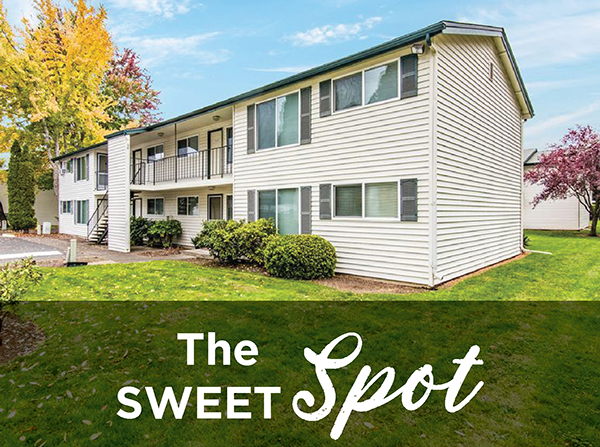Part Three: A Case for Affordable Housing
Doing Well by Doing Good Authored by Trevor Schuesler, CFA, Associate Investment Director November 17, 2021 One of America’s...

Authored by Jonathan Needell, President and Chief Investment Officer
March 18, 2022
Commercial real estate investors typically have an area of the market in which they like to focus their investments. Whether it is a certain asset class like multifamily or a geographical market like California, this is their “sweet spot”—the category that brings them the most value.
For Kairos Investment Management Company (KIMC), our sweet spot is investing in pre-institutional assets: those that are too small for institutions yet too large for individual investors. It is central to our strategy to identify properties that are below the size preferred by institutions and in markets not yet fully discovered by those institutions. We believe this focus on pre-institutional markets gives us an attractive entry point into properties that may benefit from better pricing, growth trends, and value creation opportunities than similar upmarket properties.
Here are some of the reasons why we believe middle market deals make sense for investors:
Deal Size: The competitive pool is usually smaller.
Generally speaking, fewer investors are interested in middle market deals than they are in either end of the spectrum. Institutional investors tend to focus on large-ticket trophy properties or portfolios, while individual investors look for assets they can afford to purchase independently. This means there may be less competition from these types of investors in that middle range.
When fewer people are bidding on an asset, pricing usually remains more stable and reasonable. This means middle market investors may be able to acquire properties for less money, apply a value-add strategy like we do at KIMC, and ideally generate more income. When that property is sold, the potential for a higher profit margin is typically greater than it would be for an institutional asset or one that would appeal to an individual investor because the initial investment was proportionally much lower.
Regional Exposure: A first mover advantage exists
The “pre-institutional” or emerging institutional markets that are categorized as middle market are typically fast-growing secondary regions that have been mostly undiscovered by institutional buyers. Focusing on these markets as early entrants positions investors to capture better growth dynamics and cap rate compression as buyers wait for these assets and areas to graduate to institutional markets.
This is the stance we take at KIMC, utilizing a proprietary supply-demand algorithm to identify MSAs we believe will be future institutional markets. In fact, this mindset has allowed us to achieve property-level returns in excess of our underwritten returns given our first-mover advantage.
Access: Off-market deals tend to be easier to identify.
Investors who focus on middle market transactions can more easily form relationships with property owners and brokers in that space because of the reduced competition. This means they can find out from those sources about properties that are for sale before they hit the market, which lowers their chances of getting outbid and increases their odds of closing sales.
Neither institutional nor individual investors have that advantage, which makes off-market deals in the middle market category easier to identify for those who nurture mutually beneficial relationships.
Value Creation: There are more opportunities to create value.
The nature of middle market investment provides unique opportunities for stakeholders to control asset performance. Institutional investors are disengaged from these opportunities due to deal size, and individual buyers typically don’t have the capital backing to achieve what middle market investors can.
For example, KIMC focuses our investment efforts on buying assets from non-institutional owners and implementing an institutionalized model of execution to reposition assets for purchase by institutional buyers. By playing beneath the institutional radar, we believe we are ultimately able to deliver better results than many of our peers who play upmarket
One of the ways we do this is by following a hybrid operator/allocator model, investing like an owner rather than just an allocator. We take a hands-on approach in both wholly owned and sponsor deals, which we believe allows us to both enhance returns and mitigate risk.
This hybrid approach enables us to control our success because we have less reliance on the success of third parties. Our in-house due diligence and asset management allow us to select pre-institutional partners that have great investment opportunities in the right submarkets. We can be a value-added partner to our sponsors to help create and execute a business plan to maximize value. We can also buy out sponsors to extend the value creation period in properties we know and have confidence. Additionally, we can remove sponsors in underperforming properties and remediate and reposition properties to mitigate risk.
In our opinion, the middle market holds great value for CRE investors. The ability to source deals from a smaller competitive pool, enter markets before they get overheated, identify more off-market opportunities, and take on roles that position properties for better performance makes middle market transactions a win-win for those who choose this path.
*This content is meant for informational purposes only and should not be construed as a recommendation, an offer of services, or an offer to sell, or solicitation of an offer to buy a particular security or investment strategy. There are no guarantees that any specific investment strategy will be profitable or equal to past performance levels. All investment strategies have the potential for profit or loss. The views and opinions expressed in this article are solely my own.
For questions, contact investor relations at investorreporting@kimc.com or 949-800-8500.
 Back to All
Back to All
Doing Well by Doing Good Authored by Trevor Schuesler, CFA, Associate Investment Director November 17, 2021 One of America’s...
Authored by Jonathan Needell, Associate Investment Director October 27, 2020 Investors of all stripes are frequently admonished to go...
Authored by Raymond Hu, Senior Investment Director – Head of Real Estate Credit May 2, 2023 Commercial real estate...
By Raymond Hu, Senior Investment Director – Head of Real Estate Credit October 17, 2023 Just a few years...
We Made a Promise to Strive for Deep Impact A pandemic induced dovish approach by the world’s central banks...
Authored by Jonathan Needell, President & Chief Investment Officer August 28, 2020 In the United States, the ongoing COVID-19...
Kairos is proud to be a Freddie Mac Multifamily Impact Sponsor. The Impact Sponsor Award was established in 2021...
We Made a Promise to Strive for Deep Impact 2020 was a challenging year for humankind, underscored by the...
18101 Von Karman, Suite 1100
Irvine, CA 92612
(949) 709-8888
(949) 800-8500
investorreporting@kimc.com
Copyright © 2024 Kairos Investment Management Company | Disclosures
Kairos Investment Management Company is an Equal Opportunity Employer and, as such, does not discriminate in employment on the basis of an applicant or employee’s race, ethnicity, ancestry, national origin, color, sex, pregnancy (or related medical conditions), childbirth, family status, gender, gender identity or gender expression, age, religion, marital status, sexual orientation, disability, medical condition, military or veteran status, reproductive health decision making, or any other protected classification or characteristic under applicable federal, state or local law. Kairos will not discriminate against an applicant or employee who has one or more protected classifications, is perceived or regarded as having one or more protected classifications, or is associated with someone who has one or more protected classifications.
Kairos Investment Management Company will also provide reasonable accommodations to applicants and employees who may need such accommodations in connection with employment with Kairos on the basis of their disability, religion, status as a victim of domestic violence or pregnancy. An applicant who needs an accommodation in order to pursue employment with Kairos should contact Human Resources at HR@KIMC.com to request such accommodations. Kairos will engage in a good faith interactive process with the applicant to explore accommodations that will be effective, reasonable and not create an undue hardship.
You can see how this popup was set up in our step-by-step guide: https://wppopupmaker.com/guides/auto-opening-announcement-popups/
You can see how this popup was set up in our step-by-step guide: https://wppopupmaker.com/guides/auto-opening-announcement-popups/